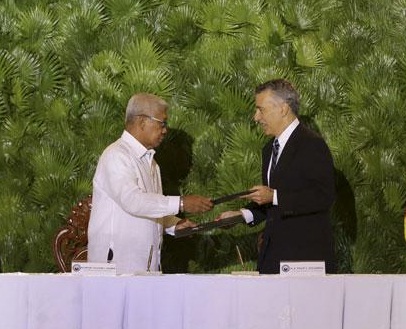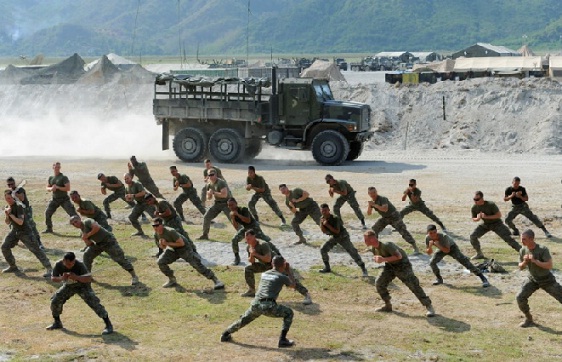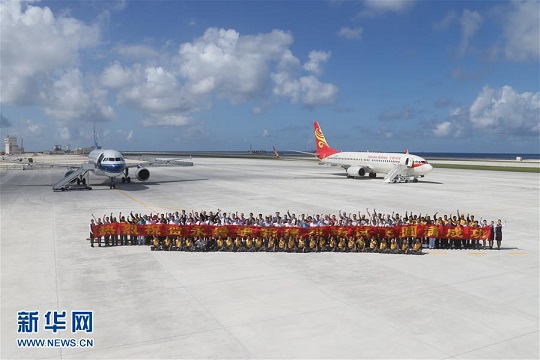
Defense Secretary Voltaire Gazmin and U.S. Ambassador Phillip Goldberg after signing the Enhanced Defense Cooperation Agreement.
In their ecstasy over the Supreme Court decision declaring the Enhanced Defense Cooperation Agreement constitutional and need not be ratified by the Senate, government officials are telling the Filipino people that the country is now in a better position to take on China in the territorial conflict in the Spratlys in the South China Sea.
The military’s spokesman even said from where the American troops would be based in the Philippines, it would take a shorter distance to the South China Sea where China has done massive reclamations around the reefs and rocks they occupy.
As if the American troops based in the Philippines would simply and quickly rush to the Spratlys and battle with Chinese Navy if China clash with the Philippine Navy in the disputed waters.
It would be good to refer to the Senate hearing in on EDCA in December 2014 when Defense Secretary Voltaire Gazmin was compelled to tell the public what EDCA is really about upon incisive questioning by Sen. Miriam Santiago, chairperson of the Senate Committee on Foreign Relations.
In that hearing, Santiago asked Gazmin: “What will the US do if a Chinese ship fires at a Philippine ship in the West Philippine Sea?”
Gazmin answered, “It’s part of the agreement that we can pull the US to join us in the fight.”
If he thought he can get away with that answer which was not exactly truthful, Santiago asked if the U.S. would immediately deploy planes and ships to fire at the Chinese, Gazmin had to admit that the deployment would go “through a process.”
Pressed further how long would the process take, Gazmin had to admit again that “The process takes long.”
Santiago made a realistic conclusion: “By that time, the [Philippine] ship has already sunk.”
The process Gazmin referred to is the provision in the 1951 Mutual Defense Treaty that an armed attack in the Pacific Area on either of the Parties would be dangerous to its own peace and safety and declares that it would act to meet the common dangers in accordance with its constitutional processes.”
In the U.S. “Constitutional processes” means the President would have to ask approval from the Congress which could take a lot of debate and time.

American and Filipino soldiers in a joint military exercise.Photo from AFP’s Exercise Balikatan Facebook
Philippine officials continue deluding the public that China would be deterred by the presence of American troops in the Philippines to carry out whatever plans it has to protect its interests when in fact the reality on the ground is the opposite.
If one looks at the timeline of China’s moves related to the South China Sea conflict, it can be said that EDCA hastened or at least was one of the reasons that China expanded in the South China Sea.
Tension in the South China Sea in the last three years remained even after the two-month standoff in Scarborough Shoal over the arrest of Chinese fishermen on April 8, 2012 ended. Two Chinese ships remained in the area giving the Chinese control over the disputed rock 124 nautical miles from the Zambales.
The Scarborough incident triggered the filing by the Philippines of a suit before the United Nations Arbitral Tribunal questioning China’s nine-dash line map in January 2013.
Negotiations for EDCA started in August 2013. The Aquino government agreed to an increased presence of American troops in the country made possible by the 1999 Visiting Forces Agreement after U.S military bases were closed in 1992. Before that, in view of the Constitutional ban on permanent presence of foreign troops in the country, the Philippine government from the time of Gloria Arroyo presidency allowed “rotational” presence of U.S. troops in the country. An agreement on PH-US Enhanced Defense Cooperation Agreement of EDCA was signed on April 26, 2014.
In Dec. 2013, China started reclaiming land in Spratlys. By June 2015, the U.S. Defense Department said China has reclaimed 2,900 acres of land mass transforming the eight rocks and reefs it occupies into islands. China has also constructed installations in the reclaimed islands.

Crew members of the two aircraft that landed in Fiery Cross Reef pose for a souvenir photo.From Xinhua.
Last week, China conducted test flights in Fiery Cross Reef, one of the man-made islands.
Buoyed by the High Court’s decision, Defense Ministry Spokesman Peter Paul Galvez now talks of joint patrol of Philippine and U.S. ships in the disputed waters.
“We are suggesting that we also patrol the area together. There is a need for more collaborative presence in the South China Sea,” Galvez said.
Lawyer Harry Roque, who was one of those who questioned the constitutionality of EDCA before the Supreme Court, asked, “What joint patrol” is Galvez talking. With only one or two ships, the Philippines has no capability to conduct joint patrol with the U.S., Roque said.
What would happen, Roque said, is the Philippines to just provide a front for the U.S. presence in the South China Sea. That would be “subterfuge,” he said.
Roque said joint patrols involving the U.S. under EDCA would only increase tension in the South China Sea.